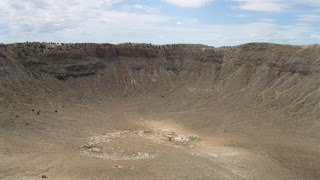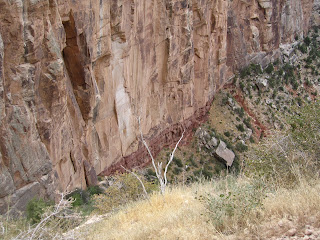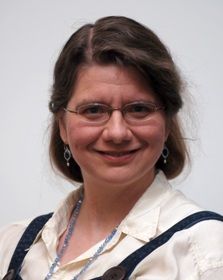Jillian E. Votava
DAY ONE: Drive from
Phoenix to Flagstaff

First impression of AZ: It’s deathly hot and dry. As we
drive out of the airport and head north along the highway though, we see a pleasant
sight: Carnegiea gigantean>>
Saguaro cacti, the giant trademarks of the desert. The drive from 1,200 ft asl
to 6,900 ft asl is most noticeable through air temperature. 110°F turns
steadily into 79°F as we gain 6,000+ feet in elevation. Along the highway, a
remarkable shift occurs: one moment you are passing an endless sea of Saguaro,
then tufts of yucca amid prickly-pear, followed by shrubs and small trees. The
final leg of the drive from Sedona to Flagstaff holds the largest surprise: Pinus ponderosa>> massive pine
trees dominate and tower over the road. We’ve just driven over a text-book
example of a basin-and-range region that has the added “spice” of regional
uplift (known as the Colorado Plateau). Ending the day with a sunset dinner at
Humphrey’s Peak included the additional surprise of Aspen and Pine
tree-climbing.
Sound of the day: wind through the tree leaves.
DAY TWO: Volcanic
Craters
First impression of SP Crater: simple cones, “fluffy” lava
flows. Classic cone-shaped volcanic hills dot the flat landscape northeast of
Flagstaff and the large lava flow snakes for four miles north of this steep,
rocky hill.
Sound of the day: wind across bare rocks, “clink-clink”
footsteps across the 70,000 year-old basalts.
First impression of
Colton crater: rounded and eroded. Colton is a large cinder-cone volcano that
was explosive and fast-lived. It is known as a hydro-volcanic crater: a rising
body of magma met ground water, creating an extremely volatile mix. The “cone”
part of the volcano is gone, it blew off! 500 feet deep and one mile in
circumference is a large volume of solid rock to expel and one can only image
what such an event would have looked like.
Fun word of the day: Palagonitic Tuff (pah-lag-on-it-ik).
DAY THREE: Crater
comparisons and petrified trees
First impression of Meteor crater: “striking”, pun only
slightly intended. You look across this flat landscape east of Flagstaff,
seeing only a couple mesas on the horizon, and then WHAM, huge hole in the ground. Thinking about a meteor the size of
a 50m by 50m building makes you panic slightly, feel small and vulnerable. This
feature is a tangible analog to our rocky neighbors in the sky. Both Mars and
(more so) the Moon are covered with impact craters. The “clinkery” rocks of
yesterday’s crater cones are gone. Here the rims are made of loosely
consolidated fragments of the strata seen in beautiful profile that make up the
crater walls. All three rock formations are of sedimentary-type; they formed
from consolidation of pre-existing materials and/or by precipitation in an
aqueous environment.
The main point: Meteor(ites) can strike ANYWHERE; volcanic-,
sedimentary-, or loose- rocks in a pile, even in the ocean! Volcanic craters
occur in volcanoes, the rim is made of volcanic rocks.

Day 3 ended with a visit to a landscape known as
“bad-lands”. This is when fluvial processes create a deeply incised and heavily
sculpted landscape of loosely-lithified sediments within an arid environment.
The water is long gone but the gullies and channels are preserved in place. The
colorful pink, orange, and purple layers as well as the mud-cracked appearance
of the ground tell you the area is full of clay. “Clay” is a broad category of
many minerals but all have variable amounts of water (H+ and OH-) in their
mineral structure. This is the Painted Desert, located within the Petrified
Forest National Park. Here, large, Cretaceous tree-logs have avoided the usual
route of decay and re-cycle by a sudden burial that removed them from oxygen
and thus allowed their overall structure to remain intact. At some point,
silica-rich waters entered the system and replaced all the carbon with an
amorphous form of quartz. The original cellulose framework remained however,
and today these logs have made their way back to the surface in an impressive
documentation of past life. Seeing these ancient tree remains is quite an
experience. A unique set of conditions tens of millions of years ago had to be
met in order for us tourists to see them now.
DAY FOUR: A natural
wonder of the world
First impression: Brain-freeze…immensity, incomprehensible
dimensions… You ask, “Is that real?” Your brain does not believe your eyes, “How CAN it be that big?”15 miles across
and one mile deep… “How did it form?” There
is a river over there, partially hidden from view, although it’s hard to
imagine the scale of time and amount of water needed to carry away such an
enormous amount of material. The origin of the Grand Canyon is still debated
and includes postulates of rapid uplift with fluvial incision or even the idea
of a giant, catastrophic sudden release of water from an upstream ancient lake.
This calm day was spent hiking down to mile 1.5 with head
up, mouth gaping, and eyes glued to the dramatic canyon walls. Below, the trail
continues across a lower bench of orange strata and then dips down out of sight
to the canyon floor. The most difficult part of this hike is NOT the inclined
ascent but instead, not seeing around the next corner. After all, “curiosity” is what drives the field of
SCIENCE.
DAY FIVE: Trip’s end
at the “Day’s End”: Sunset Crater

First impression: diverse, dramatic landscape. The final
trip is a pleasant visit to Sunset Crater National Monument. The short trail
walks over small, pebble-sized black gravel known as “cinders”. The larger
(>10cm) cinders produce a pleasing “tink” sound when stepped on. The
“tinkery” noise reveals the glassy nature of these young, volcanic rocks.
Word of the day: Hornito,
or spatter-cone: these are the smaller vents from which lava flowed out across
the land only 900 years ago! How did the people living here feel at the time of
the eruption? The creation of earth inevitably includes destruction as well.
Today, life has returned in full strength to this now fertile and nutrient-rich
volcanic dust.
Final Remarks: Post-mission debrief
Geology is largely an observational science and this field
excursion demanded most of these skills and all of my attention. The planetary
analog focus of the trip pushed my observations to the next level: to compare
and hypothesize about similar features millions of miles away on other bodies
in the solar-system. I feel privileged to have participated in such an event
and appreciative of all the planning that occurred to make it happen. Thanks to
Dr. Cynthia Cheung, Aaron Silver, and Nicole Thom for organizing the trip.
Thanks to our leaders: Dr. Patrick Burkhart, Dr. Jim Rice, Dr. Charles Shultz,
Dr. Shawn Wright, and Andy Ryan.































